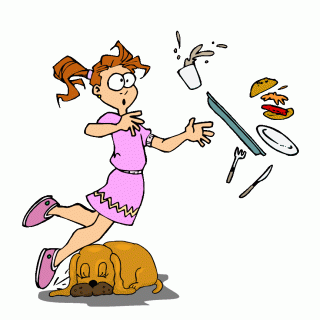Animal Behavior
Pets as a Risk Factor for Fall Related Injuries
Annually, approximately 87,000 people are injured in pet-related falls
Posted March 27, 2009
There are many studies that demonstrate the health benefits of pet ownership, however there are some circumstances where pet ownership can increase risks to those who live with them. A recent study (March 2009) conducted by researchers at the US Center for Disease Control and Prevention highlights one such risk, namely the danger of falls caused by encounters with pets.

Roughly 8 million Americans wind up in emergency rooms every year as a result of injuries due to falls. This recent CDC report described a search of five years of emergency room data on injuries using a nationally representative sample of 66 hospitals in the United States. Researchers looked for records of fall-related injuries using search terms like pet, dog, cat, puppy or kitten. From this data they then estimated that in America, about 87,000 falls that cause people to seek emergency treatment are pet related. This amounts to about 1 percent of all falls. The largest percentage of these (88 percent, or around 76,000) are dog related.
If we look at who is most likely to be injured by falls involving their pets, it is individuals who are 75 years or older, and these injuries are mostly fractures and abrasions usually to hands, arms and legs. Women are 2.1 times more likely to suffer from these accidents. Among falls involving dogs, 61.6 percent occurred in or around the home and 16.4 percent in the street or other public place. Most falls involving cats occurred at home (85.7 percent).
Fortunately, the majority of the falls, although resulting in injury, would not be characterized as severe or incapacitating. The proportion of patients that had to be hospitalized or transferred for further treatment was only 7.8 percent (around 6000) for dogs and 10.4 percent (around 1100 for cats).
An analysis of the circumstances associated with the fall-related injuries suggests that human inattention and careless behavior probably contributed to many of these falls. The most frequent situation mentioned when the fall involved a cat involved tripping or falling over the cat (66.4 percent). However the second most common state of affairs involved instances when a person was chasing the cat (11.7 percent).
For dogs, the highest number of injuries due to falls occurred while people were out walking them (26 percent). The most frequent events where dogs were involved in injuries concerned circumstances where people fell or tripped over a dog (31.3 percent) or were pushed or pulled by a dog (21.2 percent). However again, human carelessness seems to account for a sizeable number of dog injuries, such as when chasing the pet. For example tripping over a pet related item, such as a dog toy or food bowl accounted for 8.8 percent of pet-related fall injuries.
However, before one goes into a panic about the added risk of having a dog or a cat in the house, it is important to put these figures into a proper context. In 2006 approximately 43 million U.S. households had dogs as pets, and 37.5 million households had cats. Nearly 64 percent of households with pets had more than one pet. If we look at the risk of falls per year and calculate it as the risk per every 100,000 people it is only 29.7. That means to say that your individual risk of suffering from a fall is only three one hundredths (0.03) of a percent in any given year. Thus while your pet raises your risk level, it is difficult to argue that it places you in imminent danger of tripping and falling.
One does not have to be a rocket scientist to derive some clear indications of courses of action that might be taken to improve safety around pets based upon this CDC data. First, since so many of the falls occur while walking the dog, and these involve being pushed or pulled by the animal, it seems fairly obvious to suggest that dogs should be obedience trained to walk on a loose leash. Secondly, dogs large enough to be able to push or pull a person should probably be avoided by elderly individuals, since those 75 and are at the highest risk of injury. And finally, since tripping over the animal, or its toys, bowls and such like, is a sizeable risk factor, perhaps simply looking where one is going as one navigates around the house would reduce the likelihood of injury. Of course, since such recommendations are so simple and commonplace they will probably be ignored.
Stanley Coren is the author of many books including: Modern Dog, Why Do Dogs Have Wet Noses? The Pawprints of History: Dogs and the Course of Human Events, How Dogs Think : Understanding the Canine Mind, How To Speak Dog, Why We Love the Dogs We Do, What Do Dogs Know? The Intelligence of Dogs, Sleep Thieves, The Left-hander Syndrome.
Copyright SC Psychological Enterprises Ltd. May not be reprinted or reposted without permission.




